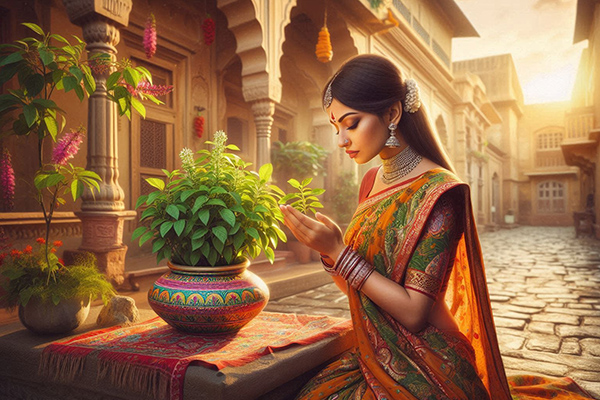
Tulsi, the holy basil is a fragrant Indian herb that is highly revered in Hindu culture. Tulsi is worshipped as an incarnation of Goddess Lakshmi, the divine consort of Lord Vishnu. Its leaves are essential in the worship of Lord Vishnu and all his avatars, including Ram, Krishna & Balaram. All parts of the Tulsi plants are used for worship and for medicinal purposes, in olden times almost all Hindu household used to have a Tulsi Plant in the middle of the house or courtyard and everyday members of the house used to offer Worship to Tulsi Plant to receive its blessings.
About Tulsi Vivah Festival
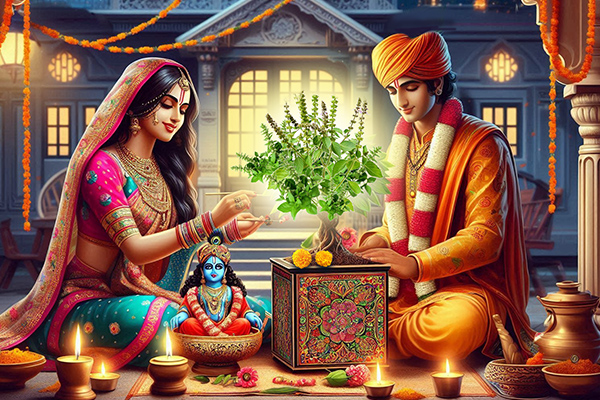
Tulsi Vivah or Tulsi Marriage is an essential part of Tulsi worship. On Ekadashi (the eleventh day) of the waxing moon in the month of Kartik, worshippers perform Tulsi Vivah, the ceremonial marriage of Tulsi with Krishna. The Tulsi Vivah Puja Vidhi is the recreation of a traditional Hindu wedding ceremony conducted in the house or a temple.
Tulsi marriage ceremony begins in the evening and worshippers performing this puja observe a fast until then. This is because it is believed that the soul of Vrinda lives in Tulsi plant at night and leaves in the morning. A wedding mandap is installed in the courtyard where the Tulsi plant resides. The bride Tulsi is bathed and dressed in a red sari and decked with jewelry. Sometimes, a paper human face may be put on Tulsi to give her a human touch. The groom is usually an image or idol of Vishnu or Krishna or even a
Shaligram stone
, bathed and wrapped in a dhoti.
For the ceremony, the bride and groom are decked with flowers and garlands before being linked with a sacred cotton thread.
Mantras
of the traditional Hindu wedding ceremony are recited and rice and kumkum is sprinkled on the couple. Most of the Tulsi Vivah puja vidhi is performed by women worshippers. The Tulsi bride is then offered gifts of sari, jewelry, sweets and even a mangal-sutra. The marriage ceremony is followed by a traditional wedding feast. The significance of Tulsi Vivah is that it marks the beginning of the annual marriage season in India.
When is Tulsi Vivah? Tulsi Vivah Date & Muhurat
Tulsi Vivah on Sunday, November 2, 2025
Dwadashi Tithi Begins - 07:31 AM on Nov 02, 2025
Dwadashi Tithi Ends - 05:07 AM on Nov 03, 2025
Tulasi Vivah Pooja Vidhi (Procedure)
Tulasi Vivah is a sacred union between the Tulsi plant and Lord Vishnu or his incarnation, often in the form of Shaligram. It is a beautiful ceremony that holds deep spiritual significance. The ceremony is conducted using age-old wedding traditions, representing the merging of the sacred and the natural, and is thought to bestow blessings of well-being, abundance, and inner enlightenment.
How To Do Tulsi Vivah? How To Do Tulasi Pooja at Home?
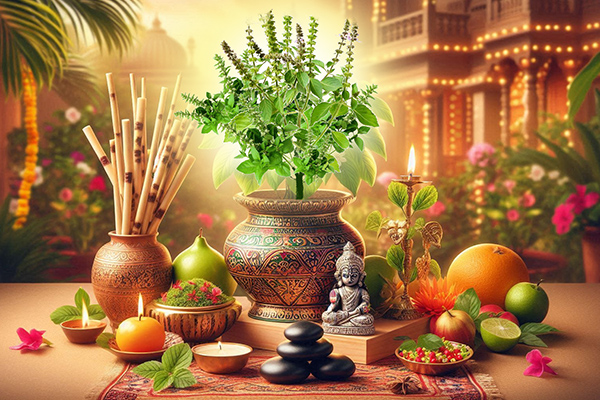
Start by setting up the mandap with four sugarcane or banana tree shoots placed on each side.
Position two chowkis side by side. Decorate the one on the right with a vibrant red cloth, while the one on the left shall be embellished with a radiant yellow cloth.
Position the Tulsi plant on the right chowki, while placing the image or idol of Lord Vishnu/Krishna or Shaligram on the left.
Next, place the Kalash gently, ensuring it is filled with water. Include a handful of uncooked rice and a small coin.
Next, add a touch of enchantment to the water by gently placing mango leaves inside. To complete the divine ambiance, delicately cover the Kalash's neck with a coconut adorned with sacred mauli.
Next, carefully position a statue of Lord Ganesha on a delicate plate and present an offering of Arghya. With a touch of artistry, Asana delicately places his idol on a bed of raw rice spread across the plate.
Include a variety of offerings such as mauli (vastra), janeu, haldi, kumkum, roli, dhoop, deep, itra, pushpa, and bhog (fruits or any sweet preparation).
May you find divine inspiration and guidance as you embark on the sacred journey of completing the Tulsi Vivah.
May your prayers be heard and may the blessings of Lord Ganesha be bestowed upon you.
Perform the sacred ritual of offering haldi and kumkum to Lord Vishnu and Tulsi Maa. Then present the chunri and shringar samagri to Goddess Tulsi, and the mauli and janeu to Lord Vishnu.
Include the garland into your ritual by presenting it to Tulsi after lightly patting it against the sacred idol or image of Lord Vishnu. Next, present the second garland to Lord Vishnu, gently brushing it against the sacred Tulsi plant.
Then present an offering to Tulsi Maa.
Now, let me share a fascinating tale. Picture this: a vibrant red chunri and a radiant yellow cloth, gracefully intertwined. As the knot is delicately tied, a handful of raw rice is carefully placed within. A mystical ritual unfolds, weaving together the threads of tradition and spirituality.
Place the yellow side next to Lord Vishnu's image and the red side near the Tulsi plant.
During the Kanya daan ritual, it is customary to hold some akshat and dakshina in your palm and offer it to Lord Vishnu.
Arrange all the offerings and bhog on a plate.
Wrap up the Vivah ceremony by performing the aarti.
Tulasi Pooja Mantra
तुलसी स्तुति मंत्र: नमो नमस्ते तुलसी पापं हर हरिप्रिये। तुलसी श्रीर्महालक्ष्मीर्विद्याविद्या यशस्विनी। धर्म्या धर्मानना देवी देवीदेवमन: प्रिया।। लभते सुतरां भक्तिमन्ते विष्णुपदं लभेत्। तुलसी भूर्महालक्ष्मी: पद्मिनी श्रीर्हरप्रिया।।
Meaning:
Salutations, salutations to you, O Tulsi, remover of sins, beloved of Lord Hari. You are the embodiment of prosperity (Shri), Mahalakshmi, the goddess of knowledge and ignorance, the one who bestows fame. You are righteous, upholder of dharma, and dear to the minds of all gods and goddesses. One who devoutly worships you gains immense devotion and ultimately attains the abode of Vishnu. You are the Earth itself, Mahalakshmi, the goddess seated on a lotus, and beloved of Lord Hari.
Tulsi Vivah Story; Why Is Tulsi Vivah Celebrated
.jpg)
Tulsi Vivah’s story begin with setting the context for two important characters namely Vrinda & Jalandhar. Tulsi Devi was Vrinda in her previous birth. To the Daityaraj Kalnemi, the King of Mathura, a girl was born. Her parents named her Vrinda. She became a devotee of Vishnu from her childhood. When Vrinda grew up, she was married to an Asura named Jalandhar.
Lord Shiva
got annoyed with Indra and opened his third eye. Guru Brihaspati apologized to Lord Shiva and requested him to forgive Indra. Therefore, Lord Shiva sent the fire from his eye into the ocean. A baby boy was born out of it. This boy became the mighty demon king Jalandhar. The name of his capital too was Jalandhar.
Having emerged from the ocean water Jalandhar staked his claim on the treasures churned out of the ocean. The gods refused to acknowledge his claim. Jalandhar declared war and became a danger to Devas (Gods). Nobody could kill him because he had the boon that till his wife Vrinda was chaste; death could not touch him.
The fierce battle went on. The Devas asked Vishnu for help. Vishnu wanted to help them but could not kill Jalandhar because of his promise to wife Lakshmi, who considered Jalandhar her brother as he too was born out of the ocean like her. So, Devas were defeated by the Asuras (demons), and Jalandhar became the king of Heaven, Earth, and Pataal (Netherworld).
.jpg)
The Devas consulted sage Narad and another plan was hatched. Accordingly, Narad went to Jalandhar and during conversation deliberately described in detail how Shiva had the most beautiful area of Kailash as his abode and the most beautiful wife Parvati. Jalandhar was egoistic and had the compulsion to acquire everything that he desired. His lust and ego propelled him to acquire both Shiva’s wife and home.
Again, a ferocious battle ensued. Jalandhar had mastered the ability to change form. While the war was going on, he disguised himself as Shiva and went to Parvati to trick her. She saw through his disguise and recognized him. She attacked him but he escaped. Parvati then complained to Vishnu and asked him to trick Vrinda just as Jalandhar had tried to trick her.
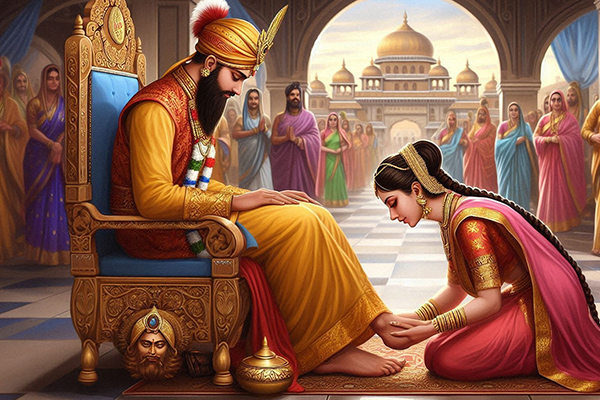
Now Vrinda, determined to stay loyal to her husband, would sit and perform pooja (prayers) whenever Jalandhar went for battle. She never got up from the pooja till he came back home. This time too, she was busy performing her pooja for the victory and long life of her husband. The Devas requested Vishnu to intervene. Vishnu was in a fix. Vrinda was his devotee. He just could not deceive her. But again, the Devas urged him. So, he took the form of Jalandhar and went to Jalandhar’s palace. Seeing him Vrinda got up from her pooja and touched his feet.
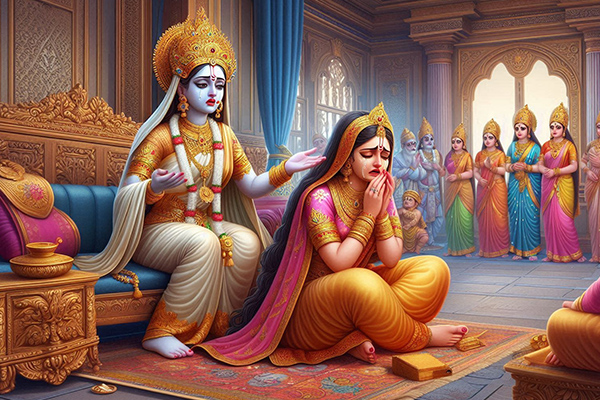
This broke Vrinda’s pledge, and her husband lost his life in the battle. Lord Shiva killed him. Jalandhar’s head was thrown in their palace. Dumbfounded she looked at her husband’s head and asked in a steely tone, ‘Who is standing before me? Whom have I touched?’ A sheepish Vishnu came into his original form. Vrinda understood that she had been tricked by him. She was angry at this deception. She cursed Vishnu to turn into the very stone, suited to the way he had behaved, since stones are heartless. And Lord Vishnu became a stone – Shaligram. The whole creation became unbalanced. Lakshmi and all the gods implored and prayed to Vrinda to take back her curse. For the welfare of the creation, she took her curse back. She took it back, but to his credit, Vishnu had taken his punishment without protest.
Vrinda took her husband’s head in her lap and immolated herself in the fire. From her ashes sprang a plant. Vishnu named that plant Tulsi. He declared that one of his forms (the stony one) would be called Shaligram and it would always be worshipped with Tulsi. Tulsi will find a place in all the houses and be worshipped. The first offering to him should be of Tulsi, otherwise, he would not accept the rest of the offerings. From then onwards started the tradition of honoring Tulsi by performing Tulsi Vivah in the month of Kartik.
Importance & Significance of Tulsi Vivah
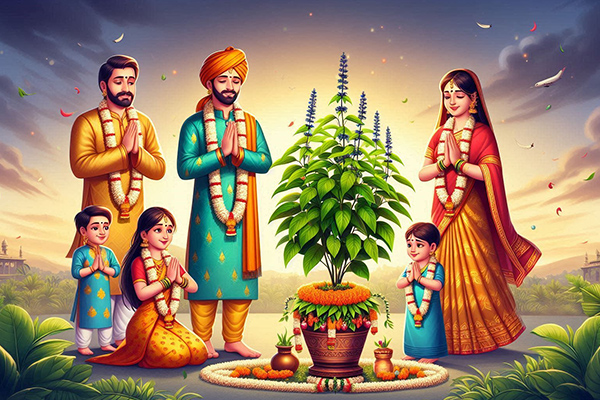
Tulsi Vivah is a beautiful Hindu festival that represents the coming together of purity, devotion, and prosperity. The celebration of Tulsi Vivah signifies the commencement of the sacred union season in Hinduism. On this day, countless weddings are celebrated. Tulsi symbolizes the sacred essence of femininity, while Lord Vishnu, the guardian of the cosmos, embodies the divine essence of masculinity. Their coming together represents a beautiful equilibrium between these two forces. May blessings be bestowed upon those who seek divine intervention in their quest for an ideal life partner and the gift of fertility. Tulsi Vivah marks the conclusion of the monsoon season. Tulsi is renowned for its numerous physiological benefits, such as its remarkable capacity to shield the body from harm caused by toxins.
How To Worship Tulsi Plant at Home
- This is a Step by Step guide for daily Worship of Tulsi Plant at Home.
- Ensure the space is pristine: Be certain that the area is spotless and that the plant is bathed in ample sunlight.
- Illuminate the surroundings: Illuminate the area by gently igniting an earthen lamp or Diyas filled with ghee in close proximity to the plant.
- Present water: Take a kalash in both hands and graciously offer water to the plant.
- Engage in the practice of chanting mantras, specifically those dedicated to Tulsi Maa.
- Present a beautiful garland or a bouquet of flowers to the plant as a gesture of appreciation.
- Circumambulate: encircling the plant seven times.
- Offer sweets: Share a delightful treat with the plant.
- Discover a collection of exquisite items to enhance your sacred rituals and decoration. Present a collection of beautiful accessories such as bangles, a saree, or a dupatta.
- Place the Shaligram near the plant to honour the divine presence and seek blessings from the Goddess.
-
Be mindful of refraining from plucking leaves on specific days: Avoid plucking leaves on Sundays or Ekadashi. For optimal results, it is recommended to gather the leaves the day prior to when you will need them.
Illuminate the evening: Following the Sandhyavandan ritual, ignite a lamp beneath the plant. -
Devotedly tending to the sacred Tulsi plant is said to have the power to alleviate life's challenges.
Tulsi Puja For Early Marriage
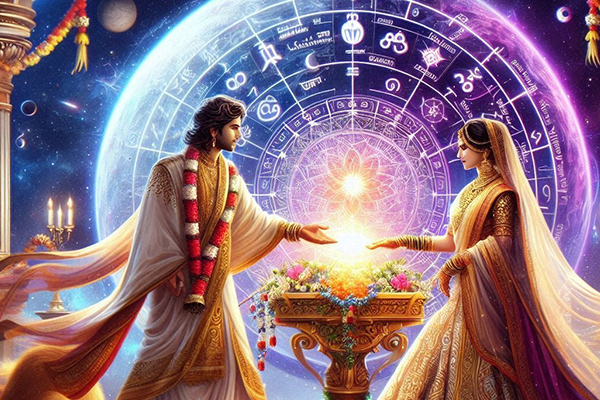
Astrology says that those who are facing obstacles in their marriage and want to get married as soon as possible should take some measures. Following these measures could remove all obstacles and one will marry the person of her choice. In short, searching for the ideal life partner will be much easier as the planets will align in a way to shower you with fortune and blessings. According to traditions and beliefs, worshiping the Tulsi plant can keep evil away from our lives. During this festival, Tulsi Vivah is performed to seek marital happiness and longevity.
Types Of Tulsi Plant
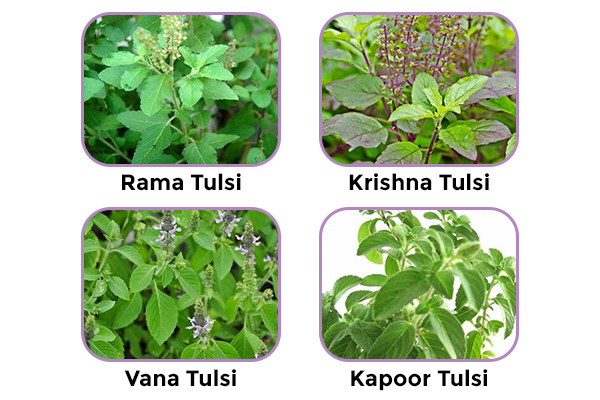
Tulsi, a plant held in high regard in Hindu tradition, holds great spiritual and medicinal significance. Tulsi, with its unique qualities and numerous advantages, holds a special place in Indian culture as a plant of great significance.
Rama Tulsi,
also known as Green Leaf Tulsi, Sri Tulasi, or Lakshmi Tulasi, is a plant with the scientific names Ocimum tenuiflorum and Ocimum sanctum.
Krishna Tulsi,
Shyama Tulsi. As the name suggests the leaves of this type of Tulsi have purple leaves like Krishna or Vishun Bhagwan.
Vana Tulsi,
(wild leaf) the name that evokes a sense of untamed nature and deep-rooted wisdom.
Kapoor Tulsi,
(heavy flowered) with its abundant blossoms, is a captivating plant that enchants the senses. Its vibrant flowers and aromatic leaves tell a tale of beauty and grace. This plant is a true artist, painting the world with its creative display of colors and scents. It has a spiritual essence that uplifts the soul and connects us to the divine.
Importance of Tulsi Plant & Importance of Tulsi leaves.
The Tulsi plant has great spiritual and therapeutic importance in Hindu culture, and it is venerated as a manifestation of Goddess Lakshmi. Tulsi, often known as the 'Queen of Herbs,' is considered a holy plant that cleanses both the surroundings and the psyche. Its leaves are considered auspicious and are often utilized in religious events such as Tulsi Vivah, which represents Tulsi's formal marriage to Bhagwan Vishnu.
Tulsi leaves are well-known for their medicinal powers, and they are often used in Ayurvedic medicines to enhance immunity, relieve respiratory problems, and improve general health. Tulsi leaves are presented to deities in religious rites because they are said to draw heavenly benefits, cleanse the environment, and provide wealth. Thus, the Tulsi plant and its leaves are essential for spiritual rituals, health, and well-being, making them a must-have in Hindu families.
Tulsi Vivah Festival Associated Products & Services
Shaligram Shila

Shaligrams with different markings signify various forms of Bhagwan Vishnu, worshipping them bestows protection, wealth, good health, pleasure and spiritual progress. Get the blessings of Bhagwan Vishnu on the occasion of Tulsi Vivah.
10 Mukhi Rudraksha

The 10 Mukhi Rudraksha is associated with joyfulness, positivity and protection. The 10 mukhi Rudraksha is ruled by Shri Krishna, the supreme protector personified.
Tulsi Mala
Tulsi Mala is a must have for all Vishnu & Krishna devotees and blesses own with peace, prosperity, purity, focus, concentration, awareness & protection. Receive the blessings of Bhagwan Vishnu on Tulsi Vivah.
Tulsi Bracelets
Tulsi, also known as Holy Basil, holds immense spiritual significance in Hinduism. These bracelets are made from Tulsi beads, which are believed to possess purifying and protective qualities. Wearing Tulsi bracelets brings immense blessings on Tulsi Vivah.
Vishnu Yantra
Vishnu Yantra can be used for achieving success, wealth, improving health, relationships, and achieving greatness. When worshiping this Yantra on Tulsi Vivah, the devotee visualizes himself being in the center of this sacred circle of sun-fire, secure and protected from all harm and illness that might befall him or her.
Anant Vishnu Puja
Worship Lord Anant and seek His blessing of prosperity, wealth, abundance and happiness on Tulsi Vivah. Anant Vishnu is the infinite manifestation of Lord Vishnu.

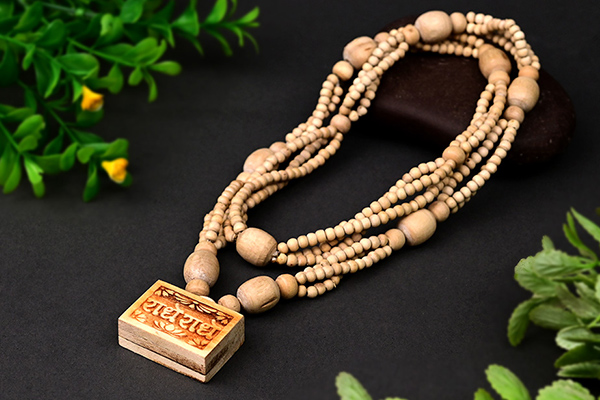

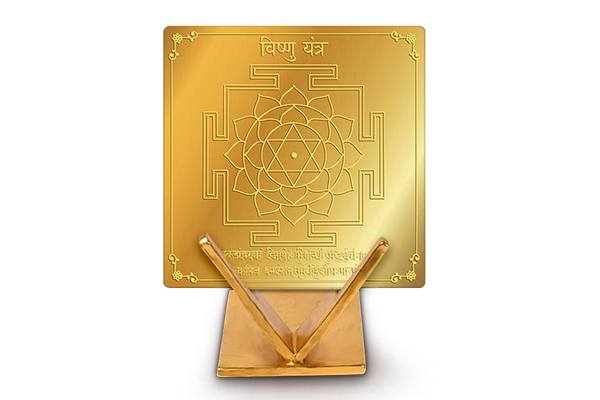
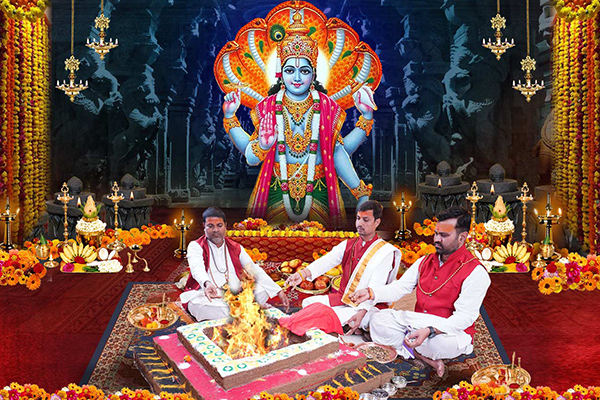



.jpg)
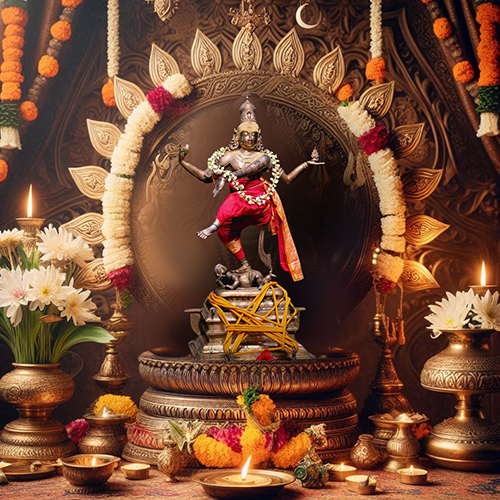
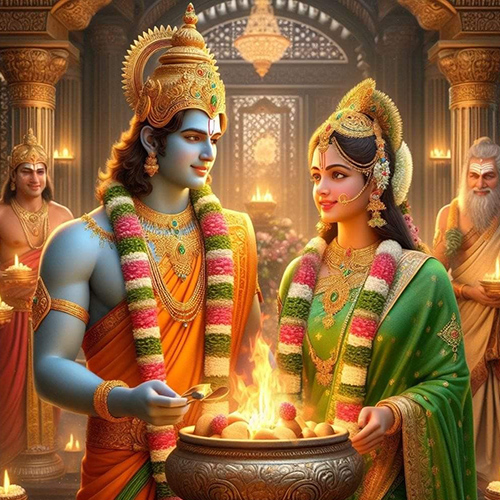
Comments 0
Leave your thought here